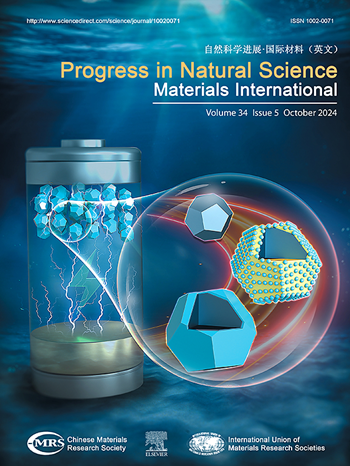Dense carbon nanofiber self-supporting electrode fabricated by orientation/compaction strategy for high volumetric lithium storage capacity
IF 7.1
2区 材料科学
Q2 MATERIALS SCIENCE, MULTIDISCIPLINARY
Progress in Natural Science: Materials International
Pub Date : 2025-02-01
DOI:10.1016/j.pnsc.2024.12.013
引用次数: 0
Abstract
Low bulk density greatly restricts the large-scale application of electrospun carbon-based fiber membrane as electrode in energy storage devices. To solve the above challenges, herein an orientation-compaction densification strategy is proposed to enhance the bulk density and volumetric capacity of PAN-based carbon nanofiber membranes as self-supporting electrode used in lithium-ion batteries (LIBs). Specifically, highly-oriented fibers are achieved by high-speed roller collecting during electrospinning, and compaction densification is conducted by hot-pressing treatment. The effects of collecting speed and hot-pressing pressure on the morphology, conductivity, bulk density, tensile strength, and flexibility of the obtained carbon nanofiber membrane are investigated. Compared to conventional fiber membranes, of which fibers are disorderly stacked, the oriented fiber membrane is much easier to achieve dense stacking by compaction. The obtained dense carbon nanofiber membrane demonstrates a bulk density of 0.566 g cm−3, and shows a significantly-enhanced volumetric capacity (318.3 mA h cm−3), high-rate performance (86.6 mA h cm−3 at 5 A g−1), and satisfactory cycling stability when used as self-supporting electrode of LIBs.

取向/压实策略制备高容量锂存储的致密碳纳米纤维自支撑电极
低堆积密度极大地限制了电纺碳基纤维膜作为电极在储能器件中的大规模应用。为了解决上述问题,本文提出了一种取向压实致密化策略,以提高pan基碳纳米纤维膜作为锂离子电池(LIBs)自支撑电极的体积密度和体积容量。具体来说,高取向纤维是通过静电纺丝过程中的高速滚筒收集来实现的,压实致密化是通过热压处理来实现的。研究了收集速度和热压压力对制备的碳纳米纤维膜的形貌、电导率、容重、拉伸强度和柔韧性的影响。与传统纤维膜的无序堆叠相比,定向纤维膜更容易通过压实实现密集堆叠。所制得的致密碳纳米纤维膜体密度为0.566 g cm−3,具有明显增强的体积容量(318.3 mA h cm−3)、高倍率性能(5a g−1时86.6 mA h cm−3)和良好的循环稳定性,可作为锂离子电池的自支撑电极。
本文章由计算机程序翻译,如有差异,请以英文原文为准。
求助全文
约1分钟内获得全文
求助全文
来源期刊
CiteScore
8.60
自引率
2.10%
发文量
2812
审稿时长
49 days
期刊介绍:
Progress in Natural Science: Materials International provides scientists and engineers throughout the world with a central vehicle for the exchange and dissemination of basic theoretical studies and applied research of advanced materials. The emphasis is placed on original research, both analytical and experimental, which is of permanent interest to engineers and scientists, covering all aspects of new materials and technologies, such as, energy and environmental materials; advanced structural materials; advanced transportation materials, functional and electronic materials; nano-scale and amorphous materials; health and biological materials; materials modeling and simulation; materials characterization; and so on. The latest research achievements and innovative papers in basic theoretical studies and applied research of material science will be carefully selected and promptly reported. Thus, the aim of this Journal is to serve the global materials science and technology community with the latest research findings.
As a service to readers, an international bibliography of recent publications in advanced materials is published bimonthly.

 求助内容:
求助内容: 应助结果提醒方式:
应助结果提醒方式:


